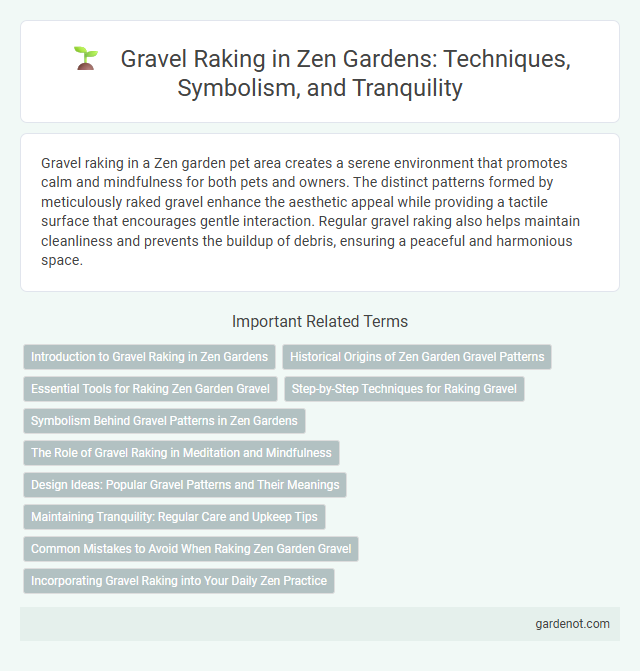Gravel raking in a Zen garden pet area creates a serene environment that promotes calm and mindfulness for both pets and owners. The distinct patterns formed by meticulously raked gravel enhance the aesthetic appeal while providing a tactile surface that encourages gentle interaction. Regular gravel raking also helps maintain cleanliness and prevents the buildup of debris, ensuring a peaceful and harmonious space.
Introduction to Gravel Raking in Zen Gardens
Gravel raking in Zen gardens serves as a meditative practice that shapes patterns symbolizing water ripples and natural flow. This technique enhances the garden's minimalist aesthetic, promoting tranquility and mindfulness through repetitive, deliberate strokes. Maintaining smooth gravel textures and carefully drawn lines is crucial for preserving the garden's harmonious and contemplative atmosphere.
Historical Origins of Zen Garden Gravel Patterns
Gravel raking in Zen gardens originated in Japan during the Muromachi period (1336-1573), where monks created intricate patterns symbolizing rippling water and natural landscapes. These gravel patterns reflect Zen Buddhism's emphasis on meditation and mindfulness, serving as visual metaphors for calmness and simplicity. The deliberate arrangement of gravel lines mimics flowing water, reinforcing the garden's role as a contemplative space for spiritual reflection.
Essential Tools for Raking Zen Garden Gravel
Essential tools for raking Zen garden gravel include a specialized wooden rake with evenly spaced tines designed to create precise patterns and smooth surfaces. These rakes come in various widths, allowing for detailed work around stones and open areas. Maintaining sharp, clean edges on the rake tines ensures optimal pattern definition and consistent gravel texture.
Step-by-Step Techniques for Raking Gravel
Start by using a specialized bamboo rake to create evenly spaced, flowing lines across the gravel surface, applying consistent pressure to avoid disturbing the stones underneath. Work in small sections, raking away from you to form smooth, parallel patterns that mimic natural water ripples, enhancing the Zen garden's tranquility. Regularly inspect and adjust your lines to maintain symmetry and remove any debris, ensuring the gravel remains pristine and visually calming.
Symbolism Behind Gravel Patterns in Zen Gardens
Gravel raking in Zen gardens symbolizes the flow of water and the patterns found in nature, representing tranquility and mindfulness. The meticulously crafted lines evoke waves, ripples, and the ebb and flow of rivers, promoting a meditative state for viewers. Each pattern variation reflects harmony and the impermanence of life, integral concepts in Zen philosophy.
The Role of Gravel Raking in Meditation and Mindfulness
Gravel raking in Zen gardens serves as a meditative practice that fosters mindfulness by encouraging focused attention and rhythmic movement. The deliberate patterns created in the gravel symbolize natural elements like water waves, promoting a sense of calm and mental clarity. This ritualistic act helps practitioners cultivate present-moment awareness and reduce stress through tactile engagement and visual harmony.
Design Ideas: Popular Gravel Patterns and Their Meanings
Gravel raking in Zen gardens often features classic patterns like concentric circles symbolizing harmony and waves representing the flow of water, promoting tranquility and meditation. Straight lines convey order and discipline, while spirals signify growth and enlightenment, each design enhancing the garden's spiritual ambiance. Choosing specific patterns aligns with traditional Zen principles, creating a visually balanced space that encourages mindfulness and reflection.
Maintaining Tranquility: Regular Care and Upkeep Tips
Gravel raking in a Zen garden is essential for preserving its serene and orderly appearance by creating rhythmic patterns that reflect tranquility and mindfulness. Consistent raking removes debris and redistributes gravel evenly, preventing erosion and maintaining smooth surface textures vital for visual harmony. Using tools like bamboo rakes and practicing gentle strokes enhances the garden's meditative ambiance while supporting its long-term upkeep.
Common Mistakes to Avoid When Raking Zen Garden Gravel
Raking Zen garden gravel requires precise patterns to maintain the intended harmony and tranquility, but common mistakes like uneven spacing or inconsistent line depth can disrupt the garden's aesthetic balance. Avoid raking too quickly or using improper tools, as this can create unwanted grooves or damage the gravel texture. Maintaining steady, deliberate motions ensures the gravel's intricate designs remain sharp and meditative, preserving the garden's symbolic representation of natural elements.
Incorporating Gravel Raking into Your Daily Zen Practice
Gravel raking in a Zen garden enhances mindfulness by encouraging focused, deliberate movements that cultivate inner calm and presence. Regularly incorporating gravel raking into your daily Zen practice helps reduce stress and sharpen concentration, aligning the mind with the garden's tranquil aesthetic. This ritual fosters a deeper connection with nature, promoting balance and clarity through the repetitive, meditative act of shaping patterns in the gravel.
Gravel raking Infographic

 gardenot.com
gardenot.com